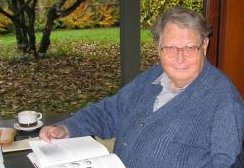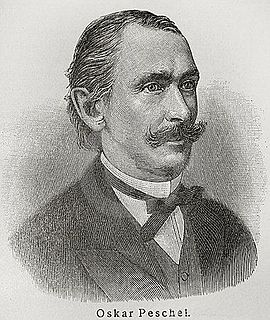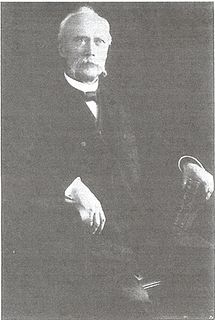
Saxony, officially the Free State of Saxony, is a landlocked federal state of Germany, bordering the federal states of Brandenburg, Saxony Anhalt, Thuringia, and Bavaria, as well as the countries of Poland and the Czech Republic. Its capital is Dresden, and its largest city is Leipzig.

Günter Blobel was a Silesian German and American biologist and 1999 Nobel Prize laureate in Physiology for the discovery that proteins have intrinsic signals that govern their transport and localization in the cell.

Leipzig University, in Leipzig in the Free State of Saxony, Germany, is one of the world's oldest universities and the second-oldest university in Germany. The university was founded on December 2, 1409 by Frederick I, Elector of Saxony and his brother William II, Margrave of Meissen, and originally comprised the four scholastic faculties. Since its inception, the university has engaged in teaching and research for over 600 years without interruption.
Karl Wilhelm Bücher was a German economist, one of the founders of non-market economics, and the founder of journalism as an academic discipline.

Saxon Switzerland is a hilly climbing area and national park around the Elbe valley south-east of Dresden in Saxony, Germany. Together with the Bohemian Switzerland in the Czech Republic it forms the Elbe Sandstone Mountains.

Arnold Graffi was a pioneering German doctor in the area of experimental cancer research.

Leipzig Hauptbahnhof is the central railway terminus in Leipzig, Germany. At 83,460 square metres (898,400 sq ft), it is the world's largest railway station measured by floor area. It has 19 overground platforms housed in six iron train sheds, a multi-level concourse with towering stone arches, and a 298 metres (978 ft) long facade. Two Leipzig City Tunnel underground platforms were inaugurated in December 2013.

Carl Friedrich Johannes von Noorden was a German historian who was a native of Bonn. He was a grandson to psychiatrist Christian Friedrich Nasse (1778–1851) and the father of pathologist Carl von Noorden (1858–1944).
Ulrich Wilcken was a German historian and papyrologist who was a native of Stettin.

Franz Studniczka was a German professor of classical archaeology born in Jasło, Galicia.
The Saxon-Bohemian Chalk Sandstone Region is a natural region in south Saxony on the southern border with the Czech Republic. It forms part of the northern perimeter of the Bohemian Massif and comprises Saxon Switzerland, the German part of the Elbsandsteingebirge and the Zittau Hills, a small section of the Lusatian Mountains on German soil. Because the boundary between the Elbsandsteingebirge and the Lusatian Uplands is on Czech territory, the two natural regions are physically separated.

Hans-Ludwig Wußing was a German historian of mathematics and science.

Oscar Ferdinand Peschel was a German geographer and anthropologist.

Gotthold Julius Rudolph Sohm was a German jurist and Church historian as well as a theologian. He published works concerning Roman and German law, Canon law and Church History.
Frank Zöllner is a German art historian and professor.

Josef A. Käs is a German biophysicist. He is a Professor at Leipzig University.
Ferdinand Sommer was a German classical and Indo-European philologist.
Richard Paul Wülker, until 1884 surname spelled as Wülcker was a German Anglist.
Friedrich Otto Hultsch was a German classical philologist and historian of mathematics in antiquity.
Andreas Glöckner is a German musicologist, a Bach scholar who has served as the dramaturge of the Bachfest Leipzig.















